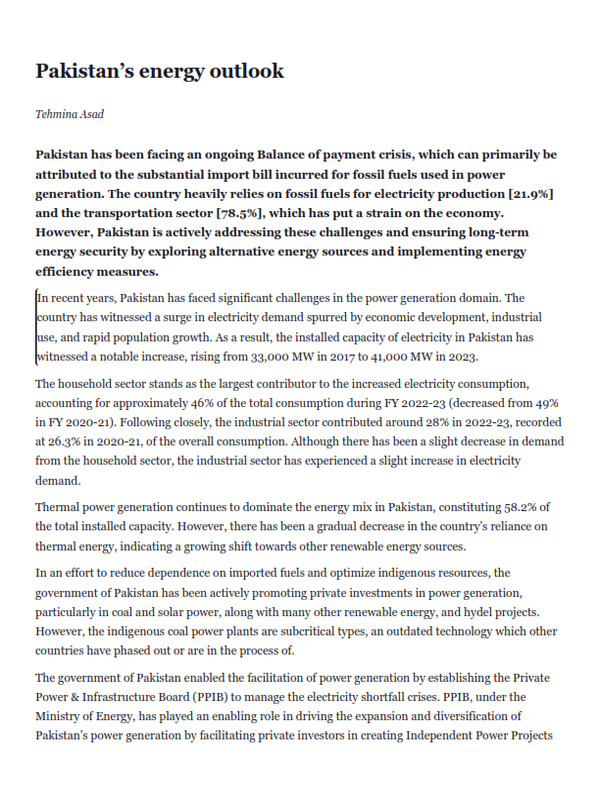
Pakistan Institute of Development Economics
- Home
Our Portals
MenuMenuMenuMenuMenuMenuMenu - ResearchMenuMenuMenuMenuMenuMenuMenu
- Discourse
- The PDR
- Our Researchers
- Academics
- Degree Verification
- Thesis Portal
- Our Portals
Pakistan’s energy outlook
Pakistan has been facing an ongoing Balance of payment crisis, which can primarily be attributed to the substantial import bill incurred for fossil fuels used in power generation. The country heavily relies on fossil fuels for electricity production [21.9%] and the transportation sector [78.5%], which has put a strain on the economy. However, Pakistan is actively addressing these challenges and ensuring long-term energy security by exploring alternative energy sources and implementing energy efficiency measures.
In recent years, Pakistan has faced significant challenges in the power generation domain. The country has witnessed a surge in electricity demand spurred by economic development, industrial use, and rapid population growth. As a result, the installed capacity of electricity in Pakistan has witnessed a notable increase, rising from 33,000 MW in 2017 to 41,000 MW in 2023.
The household sector stands as the largest contributor to the increased electricity consumption, accounting for approximately 46% of the total consumption during FY 2022-23 (decreased from 49% in FY 2020-21). Following closely, the industrial sector contributed around 28% in 2022-23, recorded at 26.3% in 2020-21, of the overall consumption. Although there has been a slight decrease in demand from the household sector, the industrial sector has experienced a slight increase in electricity demand.
Thermal power generation continues to dominate the energy mix in Pakistan, constituting 58.2% of the total installed capacity. However, there has been a gradual decrease in the country’s reliance on thermal energy, indicating a growing shift towards other renewable energy sources.
In an effort to reduce dependence on imported fuels and optimize indigenous resources, the government of Pakistan has been actively promoting private investments in power generation, particularly in coal and solar power, along with many other renewable energy, and hydel projects. However, the indigenous coal power plants are subcritical types, an outdated technology which other countries have phased out or are in the process of.
The government of Pakistan enabled the facilitation of power generation by establishing the Private Power & Infrastructure Board (PPIB) to manage the electricity shortfall crises. PPIB, under the Ministry of Energy, has played an enabling role in driving the expansion and diversification of Pakistan’s power generation by facilitating private investors in creating Independent Power Projects (IPPs).
The IPPs contributed over 50% of the installed capacity, attracting significant foreign direct investment. However, we cannot ignore that the IPPs played a role in accumulating Pakistan’s circular debt. How the awardees of these projects have exploited the situation is a matter better discussed separately.
Notable projects such as Thar coal-based plants, hydropower projects, RLNG-based Punjab Thermal Power, and the Suki Kinari project have been successfully implemented as a result of this collaboration between the Ministry of Energy and private investors. Thermal power generation has with nearly 60% share in total power production, and has, on the one hand, strengthened Pakistan’s power generation capabilities. While on the other hand, it has raised serious concerns as these projects are costly, relying largely on imported fossil fuels allowing the government to think of other cheap renewable energy solutions.
The government of Pakistan has set ambitious targets to address the country’s energy shortfall and reduce its reliance on expensive energy production methods. The goal is to achieve 60% of power generation from clean energy sources within the country by 2030, focusing on renewable options. To achieve this goal, the government has launched the Fast Track Solar Initiatives, aiming to add approximately 6,000 MW of solar photovoltaic (PV) capacity. This significant investment in solar energy will help reduce the country’s dependence on expensive imported fossil fuels.
Furthermore, decentralized solar PV projects are being implemented to improve local power infrastructure, reduce power losses, outages, and voltage issues. By procuring small-scale solar PV projects at the 11 kV feeder level, the government can enhance cost-efficiency and increase electricity supply without major upgrades to the grid infrastructure (which is another big challenge in Pakistan’s energy transmission domain).
Additionally, the solarization of public buildings through competitive bidding will not only decrease electricity bills for public offices but also alleviate long-term dues on electricity utilities and provide some relief in the circular debt, another bigger challenge that keeps the country in fiscal crises.
The government’s proposed budget includes increased PSDP, signaling ongoing support for the power sector. Additionally, plans to increase gas prices are expected to positively impact gas utilities and exploration and production (E&P) companies operating in the country.
The subsidy announced for implementing uniform tariffs and addressing tariff differentials poses numerous problems, as highlighted in a study on electricity tariff design conducted at the Pakistan Institute of Development Economics. The study recommends eliminating the subsidy to enhance the efficiency of each DISCO and reduce the circular debt. The study also proposed to increase the public sector investment in the power sector through PSDP.
To summarize, Pakistan’s incessant balance of payment crisis, primarily caused by the extensive import bill for fossil fuels used in power generation, has required a shift to other cheap & renewable alternatives, improvement in the transmission and distribution system, and serious steps to manage the circular debt crisis. The allocation of PKR 205 billion for the power sector demonstrates the government’s dedication to addressing the challenges faced within the power sector domain and improving its structure.
Copyright Business Recorder, 2023



